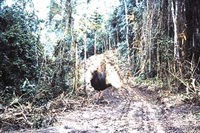
Forestry pioneer, Ross Lockyer, is back with an excerpt from his second book (of five), Cannibals, Crocodiles and Cassowaries, about his time in pre-independence Papua New Guinea (1967-73). Having spent his working life living and working in the forestry and logging industries in remote locations of South-East Asia and the Pacific, including Papua New Guinea, Borneo Irian Jaya/West Papua, Sumatra, Burma, Thailand, The Philippines, Malaysia and Kiribati, Ross captures a time in history when real adventure was still possible. This excerpt is set in 1967.
Ross Lockyer, Forest Engineer, Commonwealth New Guinea Timbers (CNGT), Bulolo, Papua New Guinea (PNG). That was me at 23 years of age and only 18 months out of NZFS ‘Ranger School’.
I was issued with my first ever company vehicle a couple of weeks after I started work; a 1942 Willys Jeep. Completely original, it included left-hand drive, crash gearbox, canvas top, no doors, heaps of built-in rattles, and minimal suspension. In fact, it felt like it had no suspension at all on those Bulolo forest roads! It was one of many ex-army Jeeps salvaged from the Americans when they departed PNG after the Second World War.
One of the subjects omitted from Ranger School training and from my previous experience was explosives and the art of blowing things up. I was very keen to learn how to use dynamite, but I really knew little about the subject other than watching my Dad loading his log-splitting gun with gun powder and blowing big, old, knotty pine logs apart.
As Roading Engineer, I was required to work ahead of the pioneer (rough) track-forming dozer and blast the big klinkii pine stumps out of the ground. Many of the trees felled along the road lines were giant klinkii pines (Auracaria hunstenii). These huge trees grew up to 90 metres tall with a girth often exceeding three metres. Most of the other tree species had root systems which could be torn out by the bulldozer rippers or chopped and prised out with the cutting edges of the dozer blade, but not the klinkii pine roots. Klinkii pines had massive tap roots which went deep down into the soil for many metres, and this made them impossible for the dozers to dig up or rip out.
My predecessor at CNGT had trained a crew of three Sepik bois (workers) to dynamite stumps and handle gelignite and blasting caps, and I inherited this crew along with the job. Shortly after I started at CNGT, I was given the key to the explosives shed located out in the middle of what was known as “the rock pile”. The rock pile consisted of kilometres of gold dredge tailings deposited by the action of the gold dredges. The tailings were up to 800 metres wide and covered the entire upper Bulolo Valley on either side of the river.
The explosives shed was a corrugated iron affair about three metres square, and it was located down inside a crater in the rock pile. The...





